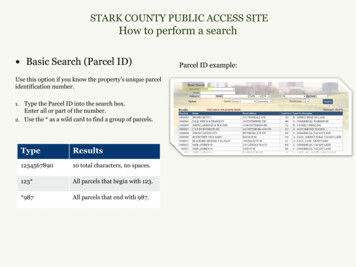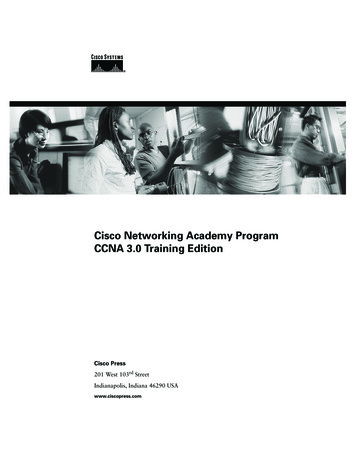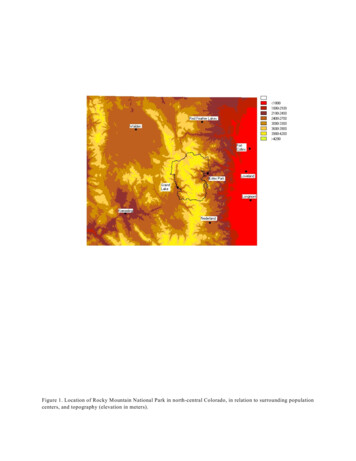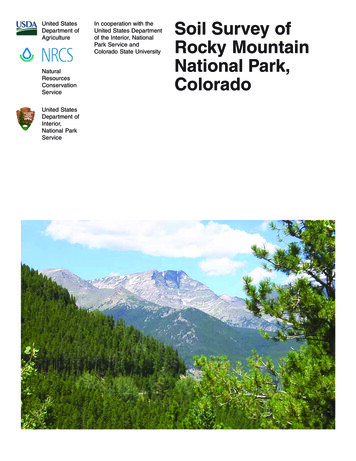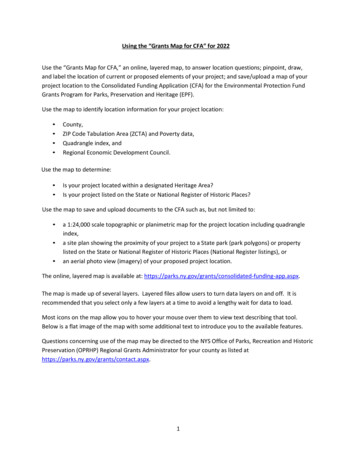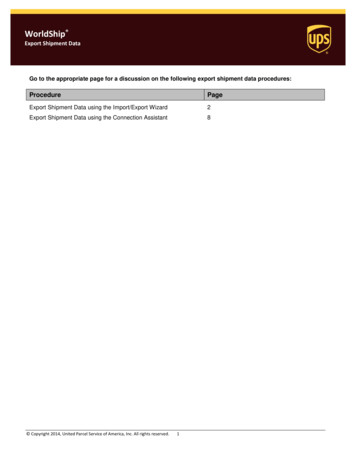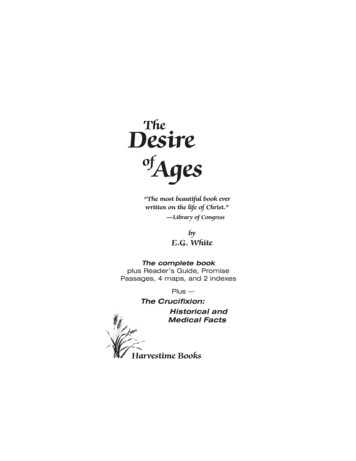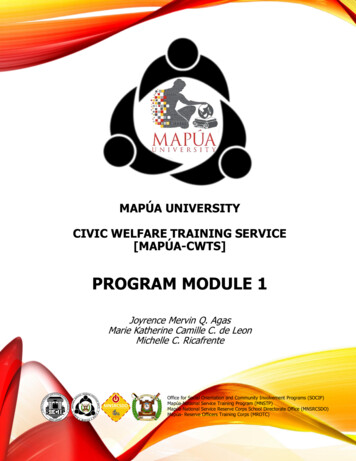
Transcription
MAPÚA UNIVERSITYCIVIC WELFARE TRAINING SERVICE[MAPÚA-CWTS]PROGRAM MODULE 1Joyrence Mervin Q. AgasMarie Katherine Camille C. de LeonMichelle C. RicafrenteOffice for Social Orientation and Community Involvement Programs (SOCIP)Mapúa-National Service Training Program (MNSTP)Mapúa-National Service Reserve Corps School Directorate Office (MNSRCSDO)Mapúa- Reserve Officers Training Corps (MROTC)
CONTENT OUTLINEINTRODUCTION TO NSTP-CWTSChapter 1: Mapúa – CWTSMAPÚA-CWTS OfficeHistory of MAPÚA-CWTSVisionMissionCourse DescriptionCWTS Student AttendanceGrading SystemStudent ActivitiesSELF-AWARENESS AND VALUES DEVELOPMENTChapter 2: The Human PersonThe Human Person: OverviewThe Human Person: RevisitedWho Am I?Core and Related ValuesThe Essence of a PersonEight Stages of DevelopmentIn a NutshellChapter 3: Filipino Social ValuesFilipino Values in the Community SettingNationalismPatriotismGROUP DYNAMICSChapter 4: GroupsDefinitionTypes of GroupsCharacteristics of GroupsFactors Affecting Group PerformanceChapter 5: TeamworkDefinitionDevelopment Stage of a TeamCreating an Effective TeamMaintaining an Effective TeamworkCelebrating SuccessBest PracticesBenefits of TeamworkHelpful and Harmful Behavior in TeamworkDysfunction of a TeamChapter 6: LeadershipDefinition21 Indispensable Qualities of a LeaderTransformational Leadership7 Habits of Highly Effective PeopleChapter 7: Decision Making and Conflict ResolutionDefinition – Decision MakingDecision Making TechniquesSteps of the Decision Making ProcessInvolvement in DecisionsDifficulties in Decision Making
CONTENT OUTLINEDefinition – ConflictStages of ConflictStrategies in Dealing with ConflictConflict Resolution Style and Problem SolvingNegotiating through a Conflict ResolutionWORKING WITH COMMUNITIESChapter 8: Dimensions of DevelopmentNSTP-CWTS Dimensions of DevelopmentSafety and SecurityEducationRecreationValues Formation and Moral RecoveryIndustry and EntrepreneurshipCare for HealthEnvironmentChapter 9: The Community and Community OrganizingThe CommunityTypes of CommunitiesCommunity OrganizationGoals of Community OrganizingGuiding Principles of Community OrganizingCommunity Organizing ProcessMethods of Community OrganizingCommunity OrganizerChapter 10: Tools for AnalysisCause and Effect WheelBarangay CabacnitanTree AnalysisBarangay Real de CacarongSWOT AnalysisBarangay LuningningChapter 11: Project DevelopmentProject PlanningWho Develops a Plan?What are the Steps in Developing a Plan?The ProjectProject Development CycleProject ProposalHow to Accomplish the Project Proposal Form?Some Helpful Tips in Assessing a Project ProposalMAPÚA-CWTS Project ProcessREFERENCESBooks and PublicationsWebsites
Introduction to NSTP-CWTSCHAPTER 1MAPÚA-CWTS OFFICE
MAPÚA UNIVERSITY – CIVIC WELFARE TRAINING SERVICE2MAPÚA-CWTS OFFICEShall serve as the coordinating body composed of MAPÚA-CWTS Program Coordinator, Staff and Facilitators.HISTORY OF MAPÚA-CWTSMapúa University, under a semestral term, initiated the National Service Training Program in the secondsemester of the school year 2001-2002. Students were given the option to choose between ROTC and CWTSas their NSTP Program.A Workbook for CWTS was developed by Engr. Edward Ted Aguinaldo, the NSTP Director, Marvin Dunmas andDr. Reynaldo A. Padilla. The workbook tackles concepts and principles regarding service, the human person,community service, nationalism and environmental protection. Subjects of the workbook were anchored to theNSTP-CWTS STET curriculum. Student activities centered on socio-civic efforts such as clean-up drive,bloodletting and Alay Lakad. Training on safety like firedrill and basic life support seminar were alsoparticipated by the students. Mini Olympics, play viewing, and orchidarium visits were conducted for culturaland recreational purposes.For the academic year 2003-2004, MAPÚA-CWTS introduced community organizing and project developmentto the students and started community-based projects. Partner communities included selected barangays inSinggalong, Sampaloc, Pandacan, San Andres, Paco, Sta. Ana and Malate. It also received the Silver Flame ofVirtue for the Kabalikat Awards 2003. This is a nationwide search for the outstanding STET-VIP NSTPcommunity project. A mural in Asamba, Project 8, Quezon City was the Institute’s entry.In the succeeding academic year, MAPÚA-CWTS underwent a curriculum innovation. With the new NSTPDirector, Engr. Joyrence Mervin Agas, the Office and selected CWTS Facilitators, a new CWTS module wascreated. It established the SERVICE Components as direction of community initiatives and the three (3)Support and Delivery System (SDS) as its implementing arm. Facilitators were designated according to theirexpertise. Technical programs such as structural survey and health-related projects like weighing were addedto the students‟ community service. Even though the LTS component is not offered as a program, its conceptis incorporated in the CWTS program through the literacy program called ALEAP-LSDS.With the Manila City government, a Memorandum of Agreement was signed stating that the Institute isadopting communities from Manila as its program site. It was decided that efforts will focus on the Pandacanarea. To better serve the community, a community survey was done.In 2005, a Community Profile of selected barangays in Pandacan was produced. This became the primary basisfor all CWTS endeavor. Also, EHSDS programs expanded in offering a computer literacy program calledComputer Fundaments Short Term Course (CFSTC) and the Water Potability Assessment Program.To organize and to formalize the documentation of student activities, the CWTS Office developed reporttemplates and assessment and evaluation instruments. Online report submission and transactions were alsoestablished for a more efficient document processing.Relevant societal concerns were discussed in class for the 2006-2007 academic year to create awareness andcivic consciousness. Classroom debates were done to test the students‟ understanding in explaining thecurrent issues besetting the country. Tools for issue analysis like cause and effect wheel and SWOT analysiswere also used to assess community needs and concerns.During the 2007-2008 academic year, the project proposal presentation was executed to uplift the quality ofproject being carried out in the community. This paved the way for a dialogue between students and theCWTS Office in improving the activities conducted in the adopted barangays.
MAPÚA UNIVERSITY – CIVIC WELFARE TRAINING SERVICE3On the second term of the 2009-2010 academic year, the SERVICE Workbook was developed. It containssituationer and community cases to better understand the SERVICE components and to enhance student’s skillin case analysis.In 2012, the academic community faced another obstacle as the country is plagued by unfavorable weatherconditions and epidemic. Severe Acute Respiratory Syndrome (SARS) scares have spread in the differentcolleges and universities. As a precaution, the academic community decided to close down their campuses toensure the safety of the students. Thus, having long periods of cancelled classes. This is also the case for thedifferent typhoons that hit the country that called for the suspension of classes.For the CWTS Office, they initiated the use of technology to continue the lectures and learnings of thestudents despite the challenges. The Office delved into online learning platforms as answer to the problem ofsuspended classes. This was later on formalized with the use of Moodle. Modular Object-Oriented DynamicLearning Environment (Moodle) provided the CWTS classes the needed contact hours and classroom dynamicswithout the actual presence in the classroom.In 2015, the University used Blackboard as their online learning platform to better cater to the needs of theclasses. As different mode of sessions are available for the students, their learnings were enriched and at parwith the experience in the classroom. Facilitators were able to use different activities and creative applicationto supplement their lectures.To respond to the call for Disaster Awareness and Preparedness, the Office started to conduct basic disastertraining. In 2017, both facilitators and students were taught basic emergency techniques such as bandaging,rope tying and rappelling. They experienced actual rappelling monitored by trained personnel of AFP.Currently, the MAPÚA-CWTS continues to enhance their curriculum in training the students to becomeresponsible citizens who could greatly contribute to the general welfare of the country. It utilizes the students’talents and technical expertise in assisting the community’s development. The program is constantly changingand adjusting to the needs of the students and the community.VISIONIn line with the Mapúa University’s vision, the MAPÚA- CWTS shall be the center of excellence in valueseducation through the promotion of civic consciousness, civic responsibility and holistic development ofindividuals to become productive members of the society.MISSIONThe MAPÚA-CWTS thrusts are: To motivate, train and organize students as catalysts of change in the community; To harness and maximize the technical expertise and interests of different schools and department andstudents’ courses to benefit the underprivileged and economically poor sectors of the society and; To develop each student to possess a high level of social awareness.
MAPÚA UNIVERSITY – CIVIC WELFARE TRAINING SERVICE4COURSE DESCRIPTIONSubject CodeDescriptionNSTP100A classroom-based discussion that encompasses the common module phase for allNational Service Training Program students. Topics include the orientation on theNSTP Law, discussion on the Human Person, The Filipino Value System, Groups,Leadership, Decision-Making, Disaster Preparedness, Awareness and Managementand Substance Abuse Education.CWTS101Classroom-based discussions concerning the introduction to MAPÚA-CWTS andlectures that introduces and promotes the MAPÚA-CWTS Dimensions of Development,relevant societal concerns, the fundamentals of working with the community andproject development.CWTS102A two-part program that re-introduces the NSTP-SERVICE components of the NSTPCWTS Dimensions of Development and the hands-on application that involves projectpreparation, planning and implementation at the assigned adopted communities.CWTS103Part 2 of the hands-on application of the acquired skills and knowledge that involvesproject preparation, planning and implementation at the assigned adoptedcommunities.CWTS STUDENT ATTENDANCE Students are required to attend their classes on time. A student who has incurred more than twenty percent (20%) absences (more than two absences) shallno longer be allowed to continue the course and will be given a final grade of five (5.00) Students who report to class fifteen (15) minutes after the official start of the class will be consideredtardy. Three (3) accumulated tardiness is equivalent to one (1) absence. Students who have failed to meet with their class and facilitator during a community-based activity willnot be allowed to follow to the said area.GRADING SYSTEMThe grading system shall be as follow:GRADEGRADE EQUIVALENTPPassedFFailedIIncompleteABSAbsent Students with an ”Incomplete” grade on his/her Final Grade Report must complete the course inaccordance with the University’s policy as stated in the Student’s Handbook. Any change of grade shall follow the University’s policy.
MAPÚA UNIVERSITY – CIVIC WELFARE TRAINING SERVICE5The following shall be the basis of student’s evaluation:AREAPERCENTAGEAttendance50%Written Exam(s)/Reports20%Student's Participation/Community Involvement30%Total100%STUDENT ACTIVITIESStudents’ initiatives are directed by connecting expertise to the community’s needs. The students are trainedto be the leading experts in their chosen career while acknowledging their social obligation. The students arebrought up to strive for the best in their field in the aim that their skills and talents would contribute to theupliftment of the society’s condition. The students‟ empowerment will serve as a tool in the progress of theirlives as well as those of others.
Self-Awareness and Values DevelopmentCHAPTER 2THE HUMAN PERSON
MAPÚA UNIVERSITY – CIVIC WELFARE TRAINING SERVICE7THE HUMAN PERSON: OVERVIEWWhat is a human person? What is the nature of a human person? How does a person attain his highestpotential that can create a positive result towards society?Even during ancient times, these questions had been consistently raised and evaluated. Brilliant psychologists,philosophers, theologians, and even natural scientists had written and made in- depth analyses on the topic ofhuman nature using wide range of theories and observations.It is essentially difficult to define man. This perspective aims to revisit and challenge, in all humility, ourperception of human nature; and the possibility of achieving a productive society through the actualization of aperson’s highest potential.THE HUMAN PERSON: REVISITEDWhen we talk about the human person, it is obviously everything that pertains to man - physical, spiritual,emotional and intellectual attributes. There are several definitions of a human person based on differentperspectives:Aristotle and Boethius described man as a rational being. As rational being, a person is able to know, reasonout and apply what he knows.Theologians describe a human person as a substance of physical and spiritual. Spiritual in nature because manhas a soul and is created by a Superior Being with a divine purpose. Physical in nature, because a person iscreated with body and faculty that correspond to his relationship with society.Dictionaries define a human person as a living, self-conscious animal or a thing.WHO AM I?To fully understand the meaning of a person, let us re-evaluate and understand the characteristics of aperson:CHARACTERISTICS OF A PERSONEddie Babor discussed in his book “The Human Person, Not Real But Existing” that the human person haveseveral characteristics, among which are the following:1. Rational - Every person is a rational being. This is what distinguishes a person from all othercreatures in the world. As a rational being, a person is free to think and has the capacity to reason. Hecan distinguish what is right and what is wrong because he has intellect.2. Free - All human beings are born free. A person has the freedom to do or not to do a specific action.However, every person must be responsible for his own action. In other words, a person can dowhatever he pleases but not to the extent of doing harm to his co-creatures.3. Unique - Every person is unique. Every person has his own identity such that no two persons are thesame. Generally speaking, human beings have the same characteristics and physical features and butno two persons are the same because every person has its own perception, has different sets ofvalues and priorities in life.4. Social being - Every person is intrinsically a social being. He cannot detach his “being” from othersand all other creatures in the universe. Human nature is characterized by his togetherness andrelationship towards other creatures; be it a thing, object or his fellowman.
MAPÚA UNIVERSITY – CIVIC WELFARE TRAINING SERVICE85. Sexual - All created living things are sexual in nature but the uniqueness of expression of a person’ssexuality makes it all different. The expression of a person’s emotions, attitudes, feelings, actions andthoughts in sexual activity best exemplifies his uniqueness from animals.Considering the characteristics, and their definitions, given above, it can be deduced that a human person isthe ultimate expression of the Supreme Being that has the freedom, capacity and ability to reason, reflect andrelate to his co-existence.CORE AND RELATED VALUESIN COMMUNITYHUMAN PERSONAS SELFDIMENSIONVALUESPHYSICALHEALTHPhysical Fitness, cleanliness, harmony with thematerial universe, beauty and artINTELLECTUALTRUTHKnowledge, creative and critical thinkingMORALLOVEIntegrity/honesty, self-worth/self-esteem, personaldisciplineSPIRITUALSPIRITUALITYFaith in GodSOCIALFamilySocietySOCIAL RESPONSIBILITYMutual Love/respect, fidelity, responsibleparenthood, concern for others/common good,freedom/equality, social justice/ respect for humanrights, peace/active non-violence, popularparticipationECONOMICECONOMIC EFFICIENCYThrift/conservation of resources, work ethics, selfreliance, productivity, scientific and technologicalknowledge, vocational efficiency, entrepreneurshipPOLITICALNATIONALISMCommon identity, national unity, esteem ofnational heroes, commitment, civic consciousness/pride, “Bayanihan”/ solidarity, loyalty to countryGLOBAL SOLIDARITYInternational understanding and cooperationSOURCE: Values Integration and Promotion: A Civic Welfare Service Core and Related Value
MAPÚA UNIVERSITY – CIVIC WELFARE TRAINING SERVICE9THE ESSENCE OF A PERSONBy understanding the character and the definition of a person, the next question would be “how are we goingto maximize these characteristics to be able to create a positive result?”There are several guiding principles in realizing a person’s competence and ability. The totality of the person isbest explored in the field of humanistic psychology. This study theorized that a person’s behavior andrelationship with others is shaped by his inner feelings and self-image.One of the foundations of humanistic psychology is Abraham Maslow and his theory on the hierarchy of needsas illustrated below:The hierarchy of needs has five levels, namely:1. Physiological Level - these are biological needs such as food, water and clothing. They are thestrongest needs because when a person is deprived of these, the person will ultimately find ways tofulfill its satisfaction.2. Safety - when physiological needs are met, the person transcends in finding security and protectionfrom physical and emotional harm.3. Social and Belongingness - when the needs for physiological and safety had been satisfied, thedesire for affection, belonging, friendship can become active. Maslow states that people seek toovercome feeling of loneliness and alienation.4. Esteem - there are two esteem needs: The self-esteem that include achievement, mastery,confidence and the esteem the person gets from others. These include recognition, respect, attentionetc. When these needs are satisfied, the person feels self-confident and valuable as a person in theworld. However, when these needs are not met, the person may feel inferior, weak, helpless andworthless.5. Self-Actualization - it is the highest form of motivation. Maslow describes this need as reaching theperson’s peak potential.As discussed above, Maslow’s theory pointed out that a person must satisfy first the other lower needsbefore he can actually realize his self-worth and potential. Accordingly, when lower needs are unmet,the person cannot fully devote himself to fulfilling his potentials (Boeree;1988). He theorized that self actualization is the driving force of human personality. Thus, a person cannot appreciate intellectual andaesthetic learning when the person is hungry and his safety is difficult to obtain. “Artistic and scientificendeavors do not flourish in a society where people must struggle for food, shelter and safety. The highestmotive - self-actualization - can only be fulfilled after all other needs are fulfilled” (Intro to Psych 10th ed byAtkinson, Smith, Bem, p. 525).
MAPÚA UNIVERSITY – CIVIC WELFARE TRAINING SERVICE10Following Maslow’s theory, Carl Rogers (1902-1987) in his person- centered therapy theory, believed thatevery person has within him an inherent desire towards a positive transformation anddevelopment of his capacity. Furthermore, he came to believe that man is basically good and inherentlypossesses a seed of goodness no matter how imprudent his actions are.The theory of person - centered therapy of Carl Rogers explained that persons are the only ones able tochange the direction of their lives and which path to take. The therapist’s role is to act as a “sounding board”while the person himself explores and analyzes his problem (Intro to Psych 10th ed by Atkinson, Smith, Bem, p523).In accordance with the view of Roger’s theory, the writer of this article personally believes that the therapistbeing referred to should not be restricted to psychologists only, but must also be identified with the person’senvironment and the people surrounding him. In other words, the role of our society should be a “soundingboard” of our reflections in life to be able for the individual to realize his problem and create his own solutionsfor it. It is the individual who will eventually direct his own life and not the people around him.THE EIGHT STAGES OF DEVELOPMENT By Erik H. EriksonPRE-SCHOOL AGE(AGES 4 – 5)EARLY CHILDHOOD(AGES 1 – 3)INFANCY(BIRTH)STAGECRISISVIRTUEBasic Trust VS. Mistrust Child is helpless dependent on adults. Caring is the satisfying needs of the child. If parents are rejecting and the satisfying needsof the child is inconsistent, it develops feelings ofmistrustHope Emerges as an enduring beliefin the attainability of ferventwishes (trusting children aremore future- oriented) Children lacking enough trustcannot hope because theymust worry constantly aboutwhether their needs will besatisfied and therefore are tiedto the present.Autonomy VS. Shame and Doubt Child develops rapidly varied skills. Learns how to hold on and let go – feces andurine. Child can willfully decide to do something ort todo it. Effects of parental discipline and control over thedevelopment of child’s own self-control. From a sense of self-control without loss of selfesteem comes lasting sense of good will andpride From a sense of self-control comes a lastingpropensity for doubt and shameWill Defined as the unbrokendetermination to exercise freechoice as well as selfrestraint.Initiative VS. Guilt Initiative – the general ability to initiate ideas andactions and to plan future events. The child begins to explore what kind of personhe can become limits are tested to find out whatis permissible and what is not. Guilt develops if parents ridicule the child’s selfinitiated behaviors and fantasies.Purpose The courage to envisage(predict or visualize) andpursue goals by defeat ofinfantile fantasies, by guilt andby foiling fear of punishment.
CRISISVIRTUESCHOOL AGE(AGES 6 – 11)Industry VS. Inferiority Industry – the sense of enjoyment from workand from sustained attention. Child learns skills necessary for economic survivalthe technological skills that will allow him tobecome productive member of his culture. School is the place where child is trained forfuture employment. Inferiority causes the child to lose confidence inhis ability to become contributing member ofsociety.Competence It is the free exercise ofdexterity and intelligence inthe completion of tasks,unimpairedbyinfantileinferiority.Identity VS. Role Confusion Identity - means essentially how a person seesthemselves in relation to their world. It's a senseof self or individuality in the context of life andwhat lies ahead. Role Confusion - the negative perspective - anabsence of identity - meaning that the personcannot see clearly or at all who they are and howthey can relate positively with their environment.Fidelity self-confidenceandselfesteem necessary to freelyassociate with people andideas based on merit, loyalty,socialandinterpersonalintegrity, discretion, personalstandards and dignity, prideand personal identity, seeinguseful personal role(s) andpurpose(s) in lifeYOUNGADULTHOOD(AGES 20 – 35)Intimacy VS. Isolation Intimacy – the ability to merge one’s identity withthat of another person. Isolation – the inability to share one’s identitywith that of another person.Love Defined as the mutuality ofdevotion forever subduing theantagonisminherentindividend functions Development of a greatersense of intimacy.Generativity VS. Stagnation Generativity – the impulse to help members ofthe next generation. Stagnation – interpersonal impoverishment – thelack of concern about the next generation.Care The widening concern forwhat has been generated bylove, necessity; it overcomesthe ambivalence adhering toirresistible obligation.Ego Integrity VS. Despair Edo Integrity – the satisfaction with life and thelack of fear of death. Despair – the lack of satisfaction with lifeWisdom The person has more egointegrity than despair Defined as detached concernwith life.TEEN AGE(AGES 12 – 19)STAGEMIDDLEADULTHOOD(AGES 36-64)11OLD AGE(AGES 65 –DEATH)MAPÚA UNIVERSITY – CIVIC WELFARE TRAINING SERVICEThe stages of development are patterned sequence encompassing appropriate physical, emotional andcognitive tasks that the individual must muster in a struggle to adjust to the demands of the socialenvironment.Each stage should be viewed as a psychosocial crisis or conflict – and whether the conflict of a particular stageis successfully resolved or not, the individual is pushed by both biological maturation and social demands intothe next stage. The conflict in each stage involves bipolar tasks such as trust vs. mistrust.
MAPÚA UNIVERSITY – CIVIC WELFARE TRAINING SERVICE12IN A NUTSHELLThe definition and characteristics of a person, the presumptions of Carl Rogers, Abraham Maslow and ErikErikson that had been analyzed are simply guiding principles and motivations to better understandourselves and examine our potentials. As JFT Bugental pointed out, “man’s life has greater possibilities but notrealized”. In other words, there are many opportunities await each person and he is blind enough not to noticethose opportunities.As discussed previously, the person himself is the best qualified in changing and directing his life. He hasalways been given an alternative whether to do or not to do an act but this action should be accompanied byresponsibility.Being human, our dealings may not always be positive but that does not negate our value as a person. Selfactualized persons allow their innate positive values to transform further and realize that by understanding hisself-first is the best way that he can effectively relate to others.Furthermore, every person must be guided by the understanding that he exists in this world achieving histemporary assignments. Each person should start now by utilizing his gifts and talents in obtaining his goals topositively transform and help others realize their worth as person themselves. He must make use of it andfulfill the greatest challenge that the Supreme Being has bestowed upon him.
Self-Awareness and Values DevelopmentCHAPTER 3FILIPINO SOCIALVALUES
MAPÚA UNIVERSITY – CIVIC WELFARE TRAINING SERVICE14FILIPINO VALUES IN THE COMMUNITY SETTINGDuring the NSTP sessions that discussed the different Filipino characteristics and Filipino Citizenship values, anunderstanding of the Filipino culture and Filipino value system was explained. It reiterated that actions,decisions and manner an individual acts and thinks can be attributed to the values they were taught andpracticed since their birth.For this chapter, it will discussed the different values that are exemplified in the social setting especially in thecommunity. It is better to keep in mind that these values are very essential in bringing forth changes andprogress in the community. These values can be an important instrument in influencing the people in thecommunity towards productive change and development.Below are several values that can help in bring together people for a common goal and advocacy.1. Pakikisama / Camaraderie – refers to an interpersonal relationship where people are friendly witheach other. To be with someone and to get along with each other indicates basic human friendlinessand affinity. It is a basic tendency for Filipinos and is expressed in their private lives, their publicworkplaces, and in their relationship with their neighbors. Filipnos believe that they live and acttogether with co-equals and consider it only natural that the consideration they show other will bereciprocated. So, people show a strong tendency to help, share and cooperate with those they arewith.2.Familial / Close Family Ties – Filipino are said to value and take good care of their family. Genuineconcern for the family is manifested in the honor and respect given to parents and elders, in thesupport and care extended to children and in the great sacrifices one endure for the welfare of thefamily. This family orientation makes every member develop a feeling of belongingness and sense ofsafety and security.3. Hospitality – refers to the warm welcome that the Filipino gives to visitors who come to his and herhome, especially strangers. Filipinos tend to create relationship and open their homes regardless ofany stereotypical biases. They are easy to get along with and treats them as though they were familymembers.4. Damayan System – refers to the sympathy for people who suffered lost and in unfavorablesituations. Filipinos tend to express their sympathy very easily and pull people in their intimate circlefor comfort and support.5. Flexibility and Adaptability – Filipinos can keep up with whatever life throw at them. They dealwith the challenges and changes in their everyday lives as it happens. They easily conforms to thesituation as well as in dealing with the unexpected. This is the ability of the Filipinos to adjust to thenorms of other groups to attain smooth and harmonious relationship. This is exemplified duringdisaster wherein many families are displaced in evacuation centers and need to cope with the hardtimes.6. Resiliency – nothing can keep the Filipino down. Even in dire situation, Filipino always find a reasonto laugh at the difficulties and proceed with their lives. This is the ability to recover and regain readilyone’s particular state and recover without intervention. This can be summed up with the phase “t
Creating an Effective Team Maintaining an Effective Teamwork Celebrating Success Best Practices Benefits of Teamwork Helpful and Harmful Behavior in Teamwork Dysfunction of a Team Chapter 6: Leadership Definition 21 Indispensable Qualities of a Leader Transformational Leader



